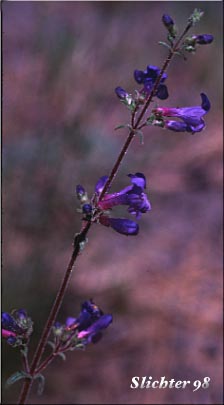 Characteristics:
Characteristics:
Lowly penstemon is a moderate-sized, several to many-stemmed perennial wildflower. Its flowering stems are between 5 and 35 cm tall. It is slender in appearance, and has many sterile stems at the base. It may appear to be somewhat matted. The leaves are both basal and on the stems. The basal leaves are 2-5 cm in length, entire, petioled and elliptic in shape. The cauline leaves are much shorter, sessile, and clasping. They are narrowly lanceolate in shape.
The inflorescence is glandular, and consists of 2-9 several-flowered verticillasters which are open below and more crowded above. The corolla is a bright blue to blue-violet in color with a lighter throat containing purplish guide lines. The corollas range from 1.0-1.7 cm in length. The corolla is definitely two-lipped, the lips moderately spreading. The corolla is glandular outside. The calyx is glandular with the sepals 2.5-6 mm long, Each sepal is broad in outline, tapering to narrow, pointed tips. The anthers are glabrous and purple outside, the sacs splitting their full length. The staminode either is fully within the tube or barely reaching the mouth. It is bearded with a tuft of short golden hairs at the tip or along the outer 1/3 of its length.
Lowly penstemon is found in dry, rocky or gravelly plains and foothills, but may be found to fairly high mountain elevations. It is often found associated with sagebrush, juniper, and ponderosa pine.
Lowly penstemon is found from the central Washington south along the eastern edge of the Cascade Mts into northern California, and eastward across the Snake River basin of Idaho into western Wyoming, and south into Nevada and Utah.